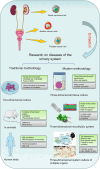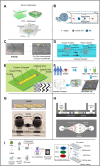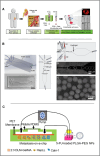The Application of Microfluidic Chips in Primary Urological Cancer: Recent Advances and Future Perspectives
- PMID: 40390767
- PMCID: PMC12087401
- DOI: 10.1002/smmd.70010
The Application of Microfluidic Chips in Primary Urological Cancer: Recent Advances and Future Perspectives
Abstract
The research of primary urological cancers, including bladder cancer (BCa), prostate cancer (PCa), and renal cancer (RCa), has developed rapidly. Microfluidic technology provides a good variety of benefits compared to the heterogeneity of animal models and potential ethical issues of human study. Microfluidic technology and its application with cell culture (e.g., organ-on-a-chip, OOC) are extensively used in urological cancer studies in preclinical and clinical settings. The application has provided diagnostic and therapeutic benefits for patients with urological diseases, especially by evaluating biomarkers for urinary malignancies. In this review, we go through the applications of OOC in BCa, Pca and Rca, and discuss the prospects of reducing the cost and improving the repeatability and amicability of the intelligent integration of urinary system organ chips.
Keywords: in vitro model; microfluidic technology; organ‐on‐a‐chip; urological cancer.
© 2025 The Author(s). Smart Medicine published by Wiley‐VCH GmbH on behalf of Wenzhou Institute, University of Chinese Academy of Sciences.
Conflict of interest statement
The authors declare no conflicts of interest.
Figures





Similar articles
-
Organ-On-A-Chip Devices: Technology Progress and Challenges.Chembiochem. 2024 Dec 2;25(23):e202400580. doi: 10.1002/cbic.202400580. Epub 2024 Oct 23. Chembiochem. 2024. PMID: 39183173 Review.
-
Applications of Polymers for Organ-on-Chip Technology in Urology.Polymers (Basel). 2022 Apr 20;14(9):1668. doi: 10.3390/polym14091668. Polymers (Basel). 2022. PMID: 35566836 Free PMC article. Review.
-
[Applications of microfluidic paper-based chips in environmental analysis and detection].Se Pu. 2021 Aug;39(8):802-815. doi: 10.3724/SP.J.1123.2020.09004. Se Pu. 2021. PMID: 34212581 Free PMC article. Chinese.
-
Engineering Shelf-Stable Coating for Microfluidic Organ-on-a-Chip Using Bioinspired Catecholamine Polymers.ACS Appl Mater Interfaces. 2020 Feb 12;12(6):6910-6923. doi: 10.1021/acsami.9b20826. Epub 2020 Feb 4. ACS Appl Mater Interfaces. 2020. PMID: 31971367
-
The crossing and integration between microfluidic technology and 3D printing for organ-on-chips.J Mater Chem B. 2018 Oct 21;6(39):6191-6206. doi: 10.1039/c8tb01661e. Epub 2018 Sep 13. J Mater Chem B. 2018. PMID: 32254609
References
-
- Sung H., Ferlay J., Siegel R. L., et al., “Global Cancer Statistics 2020: GLOBOCAN Estimates of Incidence and Mortality Worldwide for 36 Cancers in 185 Countries,” CA: A Cancer Journal for Clinicians 71 (2021): 209. - PubMed
-
- Kriegmair M. C., Rother J., Grychtol B., et al., “Multiparametric Cystoscopy for Detection of Bladder Cancer Using Real‐Time Multispectral Imaging,” European Urology 77 (2020): 251. - PubMed
-
- Siegel R., Ma J., Zou Z., and Jemal A., “Cancer Statistics, 2014,” CA: A Cancer Journal for Clinicians 64 (2014): 9. - PubMed
-
- Gandaglia G., Leni R., Bray F., et al., “Epidemiology and Prevention of Prostate Cancer,” European Urology Oncology 4 (2021): 877. - PubMed
-
- Suarez‐Ibarrola R., Sigle A., Eklund M., et al., “Artificial Intelligence in Magnetic Resonance Imaging–Based Prostate Cancer Diagnosis: Where Do We Stand in 2021,” European Urology Focus 8 (2022): 409. - PubMed
Publication types
LinkOut - more resources
Full Text Sources

